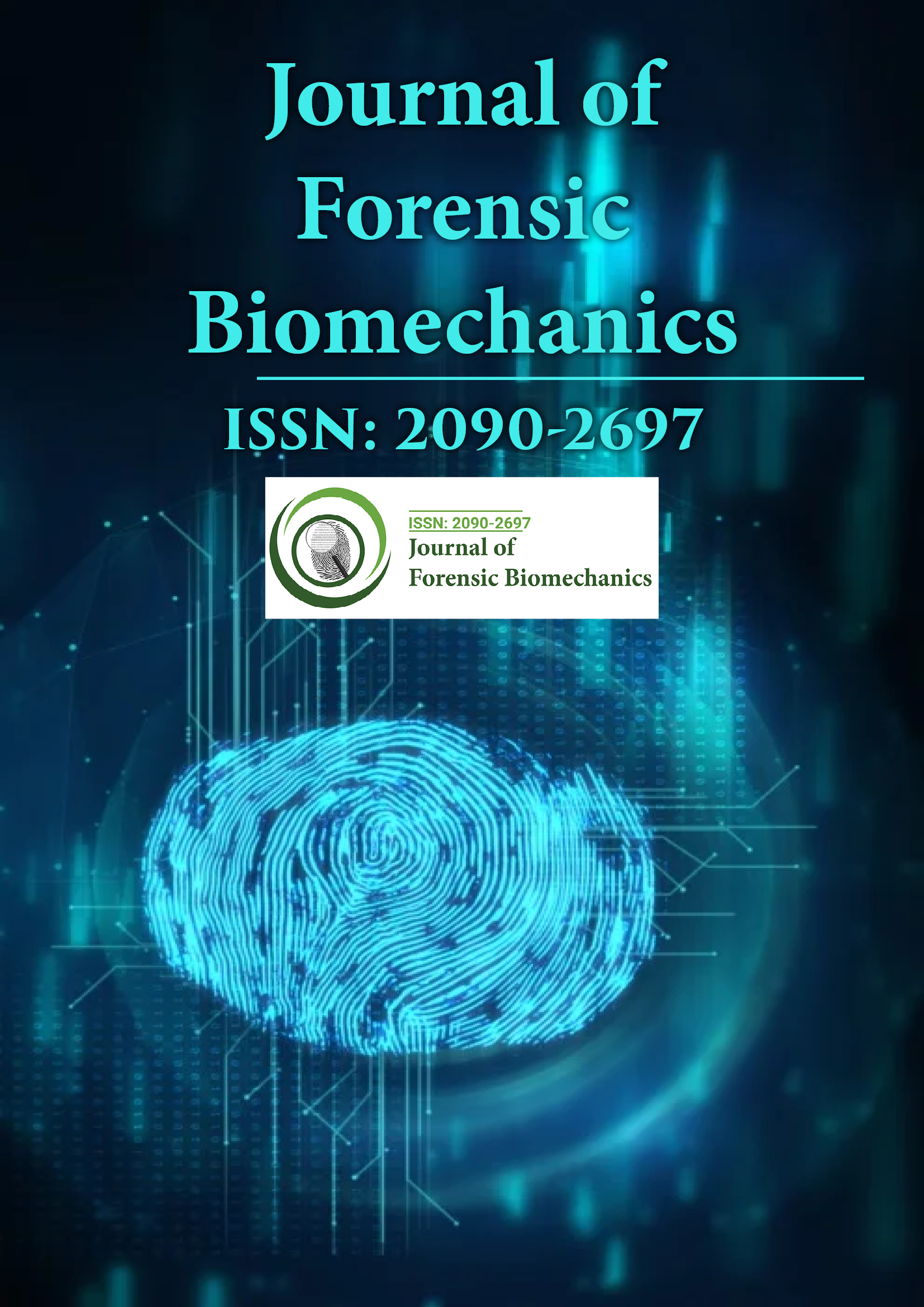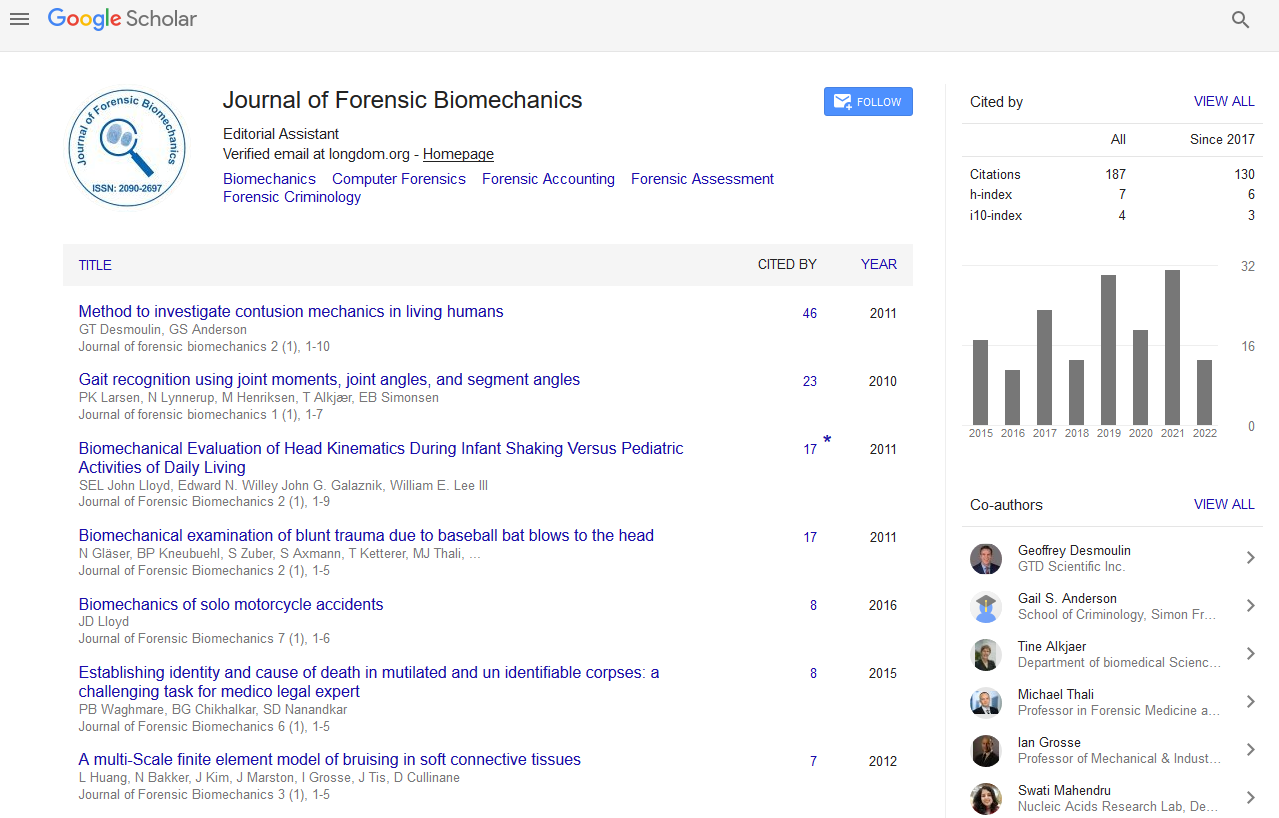Indexed In
- Genamics JournalSeek
- SafetyLit
- Ulrich's Periodicals Directory
- RefSeek
- Hamdard University
- EBSCO A-Z
- Geneva Foundation for Medical Education and Research
- Euro Pub
- Google Scholar
Useful Links
Share This Page
Journal Flyer

Open Access Journals
- Agri and Aquaculture
- Biochemistry
- Bioinformatics & Systems Biology
- Business & Management
- Chemistry
- Clinical Sciences
- Engineering
- Food & Nutrition
- General Science
- Genetics & Molecular Biology
- Immunology & Microbiology
- Medical Sciences
- Neuroscience & Psychology
- Nursing & Health Care
- Pharmaceutical Sciences
Perspective - (2022) Volume 13, Issue 5
Machine Analysis and Role of a Biomechanics in Forensic Science
Cristina Sloan*Received: 25-Aug-2022, Manuscript No. JFB-22-18532; Editor assigned: 30-Aug-2022, Pre QC No. JFB-22-18532 (PQ); Reviewed: 13-Sep-2022, QC No. JFB-22-18532; Revised: 20-Sep-2022, Manuscript No. JFB-22-18532 (R); Published: 29-Sep-2022, DOI: 10.35248/2090-2697.22.13.407
About the Study
Forensic biomechanics now-a-days regularly becoming a significant aspect of forensic technology. Forensic biomechanics is an evidence-based technology that applies biomechanical ideas and strategies to forensic exercise, which has constituted one of the maximum capacity studies areas. The main concept of this forensic biomechanics is to introduce how finite detail strategies may be used to simulate forensic instances, how damage standards and damage scales may be used to explain damage severity, and the way assessments of postmortem human topics may be used to offer vital validation data. With the development of the modern-day rule of law, forensic technology performs an increasing number of crucial positions in prison exercises and has regularly come to be a crucial approach to making sure of judicial justice. Forensic scientists often stumble upon traumaassociated instances in exercise and want to provide an explanation for the reasons for damage, including the sort and electricity of outside forces and the bio mechanisms of damage. The gear variety from the easy 3-dimensional modeling surroundings symbolizes the geometries as much as the analytical fashions primarily based totally on the free-frame diagram and the multi body numerical fashions of inflexible bodies. Through that gear, the forensic bioengineering professional is capable of remedying complicated troubles with the aid of using presenting quantitative outcomes primarily based totally on a systematic approach. There are 3 case studies to represent actual instances that have been handled in court and are presented. They relate to injuries that happened in special contexts. The first pertains to a twist of fate in a filament manufacturing facility in which an employee remained together along with the frame caught with inside the manufacturing line, the second one is the hit of a pedestrian, and the final regarding an employee who fell from a wall on a production site.
Recently, bioengineering professionals have become increasingly involved in forensic disputes, given the complexity of human contact devices. Usually in case of an accident one can request a rebuild of the dynamics. For example, you can request an injury response to a possible work accident. Sometimes the dynamics are known from a qualitative point of view, and experts need to make a quantitative assessment. This is the case of traffic accidents or work accidents where the authority to decide the case arises. 3D modeling of the body and environment in which an accident occurred is extremely useful, given the potential to report large amounts of information all in the same space and place them in interrelationships that contribute to eliminating the possibility of leading to contradictions.
Recently, biomechanics have been gradually applied in the field of forensics. Interdisciplinary research has contributed to the rapid development of biomechanical technology and the creation of many related fields in medicine, exercise science, accident reconstruction, public health, and dentistry. Forensic biomechanics is an evidence-based science that applies the principles and methods of biomechanics to forensics. Forensic biomechanics focuses on the study of the causes of forensic phenomena. Forensic phenomena are often a significant factor in personal injury, civil, and criminal cases. If experts are aware of the differences between the requirements of ligation and those of basic and applied research, expert opinion can play an important role in the decision-making process that characterizes litigation. Because the biomechanics of forensic injury is at the heart of the causality debate and causality is often a key to determining guilt, the biomechanics of forensic injury is responsible for any personal injuries, products, and buildings. , wrongful death, and can be a determinant in criminal cases.
Citation: Sloan C (2022) Machine Analysis and Role of a Biomechanics in Forensic Science. J Forensic Biomech.13:407.
Copyright: © 2022 Sloan C. This is an open-access article distributed under the terms of the Creative Commons Attribution License, which permits unrestricted use, distribution, and reproduction in any medium, provided the original author and source are credited.

